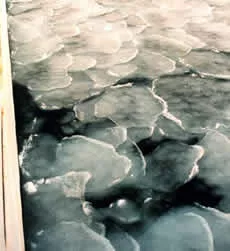Cryosphere glossary
a lead that connects two open bodies of water; ships can traverse between them through this lead; it also refers to a lead where open water is found, or a lead that has not completely frozen.
a body of unfrozen ground that penetrates the permafrost completely, connecting suprapermafrost and subpermafrost water.
a large area of freely navigable water in which floes may be present in concentration under 1/10th; if there is no sea ice present, the area may be termed open water, even though icebergs are present.
ice formed in an open cavity or crack in the ground by reverse sublimation of water vapour.
freezing that occurs under conditions that allow gain or loss of water by the system.
a pingo formed by doming of frozen ground; caused by groundwater that moves downslope through taliks and onto the pingo surface, where it freezes.
a distinct soil micromorphology, resulting from the effects of freezing and thawing processes, in which coarser soil particles form circular to ellipsoidal patterns.
an organic soil having a surface layer containing more than 17% organic carbon by weight, with permafrost within 1 meter (3.3 feet) below the surface.
any catastrophic flooding from a glacier; may originate from trapped water in cavities inside a glacier or at the margins of glaciers or from lakes that are dammed by flowing glaciers.
a valley glacier which drains an inland ice sheet or ice cap and flows through a gap in peripheral mountains.
a nearly colorless (but faintly blue) gaseous form of oxygen, with a characteristic odor like chlorine; has a formula of O3 and a molecular weight of 48; found in trace quantities in the earth's atmosphere at all times, primarily in the stratosphere between heights of about 10 to 50 kilometers (6 to 31 miles; the ozonosphere or ozone shield) where its production results from photochemical processes involving ultraviolet radiation; its maximum concentration occurs between 20 to 25 kilometers (12 to 16 miles); in the lower atmosphere, ozone is commonly formed as a product of electrical discharges through the air.
stratospheric ozone layer, giving protection to the earth's surface due to intense absorption of harmful solar ultraviolet radiation by the gas.
stratospheric ozone layer, giving protection to the earth's surface due to intense absorption of harmful solar ultraviolet radiation by the gas.
ice that is not attached to the shoreline and drifts in response to winds, currents, and other forces; some prefer the generic term drift ice, and reserve pack ice to mean drift ice that is closely packed.
a peaty permafrost mound possessing a core of alternating layers of segregated ice and peat or mineral soil material.
a poorly-drained lowland underlain by organic-rich sediments, which contains perennially frozen peat bodies (peat plateaux) and, occasionally, palsas.
pieces of new ice approximately circular, up to 10 centimeters (4 inches) thick and 0.03 to 3 meters (0.1 to 9.8 feet) in diameter, with raised edges that form from rubbing against each other; formed from the freezing together of grease ice, slush or shuga, or the reaking up of ice rind or nilas.
Image

National Oceanic and Atmospheric Administration/Department of Commerce
(1) a term used loosely by many meteorologists for almost any meteorological quantity or element (2) an arbitrary constant or variable appearing in a mathematical expression; changing it can give various outcomes for the phenomena represented.